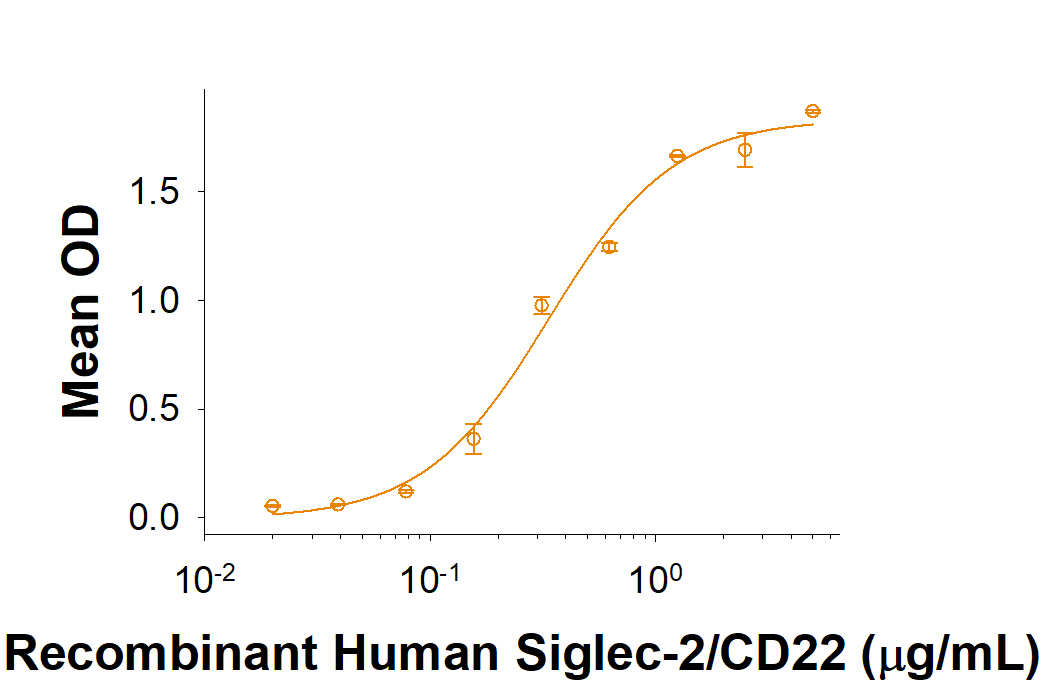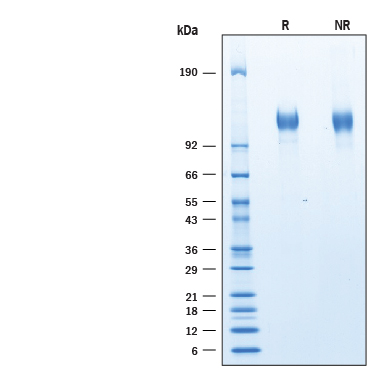Recombinant Human Siglec-2/CD22 His-tag Protein, CF Summary
Product Specifications
Analysis
Product Datasheets
Carrier Free
CF stands for Carrier Free (CF). We typically add Bovine Serum Albumin (BSA) as a carrier protein to our recombinant proteins. Adding a carrier protein enhances protein stability, increases shelf-life, and allows the recombinant protein to be stored at a more dilute concentration. The carrier free version does not contain BSA.
In general, we advise purchasing the recombinant protein with BSA for use in cell or tissue culture, or as an ELISA standard. In contrast, the carrier free protein is recommended for applications, in which the presence of BSA could interfere.
10191-SL
| Formulation | Lyophilized from a 0.2 μm filtered solution in PBS. |
| Reconstitution | Reconstitute at 500 μg/mL in PBS. |
| Shipping | The product is shipped at ambient temperature. Upon receipt, store it immediately at the temperature recommended below. |
| Stability & Storage: | Use a manual defrost freezer and avoid repeated freeze-thaw cycles.
|
Scientific Data
 View Larger
View Larger
Recombinant Human Siglec-2/CD22 His-tag (Catalog # 10191-SL) supports the adhesion of human red blood cells. The ED50 for this effect is 0.05‑0.6 μg/mL.
 View Larger
View Larger
2 μg/lane of Recombinant Human Siglec-2/CD22 His-tag (Catalog # 10191-SL) was resolved with SDS-PAGE under reducing (R) and non-reducing (NR) conditions and visualized by Coomassie® blue staining, showing bands at 110-130 kDa.
Reconstitution Calculator
Background: Siglec-2/CD22
Siglecs are type I transmembrane proteins that belong to the immunoglobulin (Ig) superfamily and function as mammalian lectins (1). They are characterized by an extracellular domain consisting of various numbers of Ig domains with a conserved N-terminal V-set Ig ligand-binding domain. This binds species-specific sialic acid motifs on protein and lipid scaffolds to regulate intracellular signaling pathways (2). The cytoplasmic tail has signaling motifs, in most cases immunoreceptor tyrosine-based inhibitory motif (ITIM) (3). Human Siglec-2, also known as B cell antigen CD22 or B lymphocyte cell adhesion molecule (BL-CAM), is a B cell restricted glycoprotein that is expressed in the cytoplasm of progenitor B and pre B cells and on the surface of mature B cells. Two distinct human Siglec-2/CD22 cDNAs that arise from differential RNA processing of the same gene have been isolated. The predominant Siglec-2/CD22 beta encodes an 847 amino acid (aa) polypeptide with a hydrophobic signal peptide, an N-terminal Ig-like V type domain, six Ig-like C2 type domains, a transmembrane region and a cytoplasmic tail with 4 immunoreceptor tyrosine-based inhibition motifs (ITIMs) (4). The variant Siglec-2/CD22 alpha encodes a 647 aa polypeptide missing two Ig-like C2 type domains and has a truncated (23 aa) cytoplasmic tail (5). Mature human Siglec-2 beta consists of a 668 amino acid (aa) extracellular domain (ECD), a 19 aa transmembrane segment, and a 141 aa cytoplasmic domain. Within the ECD, human Siglec-2 shares 59% and 58% aa sequence identity with the mouse and rat Siglec-2, respectively. Siglec-2/CD22 is an adhesion molecule that preferentially binds alpha 2,6- linked sialic acid on the same (cis) or adjacent (trans) cells. Interaction of CD22 with trans ligands on opposing cells was found to be favored over the binding of ligands in cis (6). Besides its role as an adhesion molecule, Siglec-2/CD22 is a coreceptor that physically interacts with B-cell receptor (BCR) and is rapidly phosphorylated upon BCR ligation. It negatively regulates BCR signals by recruiting tyrosine phosphatase SHP-1 to its ITIMs. Phosphorylated Siglec-2/CD22 can also interact with other intracellular effector proteins such as Syk, PLC gamma, PI3 kinase and Grb-2, suggesting it may play a role in positive signaling (7-9). Another function of CD22 is that it mediates the anti-phagocytic effect of alpha 2,6-linked sialic acid, and inhibition of CD22 promotes the clearance of myelin debris, amyloid-beta oligomers and alpha -synuclein fibrils in vivo(10). CD22 also plays a role in autoimmunity and has great potential for CD22-based immunotherapeutics for the treatment of autoimmune diseases such as systemic lupus erythematosus (SLE) (11).
- Crocker, P.R. et al. (2007) Nat. Rev. Immunol. 7:255.
- Poe, J.C. and T.F. Tedder (2012) Trends Immunol. 33:413.
- Meyer, S.J. et al. (2018) Front. Immunol. 9:2820.
- Wilson, G.L et al. (1991) J. Exp. Med. 173:137.
- Stamenkovic, I. and B. Seed (1990) Nature 345:74.
- Collins, B.E. et al. (2004) Proc. Natl. Acad. Sci. 101:6104.
- Crocker, P.R. and A. Varki (2001) Immunology 103:137.
- Ravetch, J.V. and L.L. Lanier (2000) Science 290:84.
- Wienands, Y.J. et al. (1999) J. Biol. Chem. 274:18769.
- Pluvinage, J.V. et al. (2019) Nature. 5568:7751.
- Clark, E.A. et al. (2018) Front. Immunol. 9:2235.
FAQs
No product specific FAQs exist for this product, however you may
View all Proteins and Enzyme FAQsReviews for Recombinant Human Siglec-2/CD22 His-tag Protein, CF
There are currently no reviews for this product. Be the first to review Recombinant Human Siglec-2/CD22 His-tag Protein, CF and earn rewards!
Have you used Recombinant Human Siglec-2/CD22 His-tag Protein, CF?
Submit a review and receive an Amazon gift card.
$25/€18/£15/$25CAN/¥75 Yuan/¥2500 Yen for a review with an image
$10/€7/£6/$10 CAD/¥70 Yuan/¥1110 Yen for a review without an image

